10 Best Wood Planers in 2025 – Reviews & Buying Guide

Squaring and straightening stock or boards is always an essential part of the projects for most woodworkers. And to perform these important tasks one needs to have the best wood planer.
Wood planers are one of those tools that you would expect to find in any workshop or worksite where wood is one of the key materials. These handy tools come in various types from the simple traditional hand planers to advanced jointer planer combo models.
Regardless of the wood planer type you prefer to use or are looking for, you should always aim to get the best model or at least something that makes planing easier and more efficient.
This piece aims to help make your planer choice a lot easier, and it does this by providing reviews of some of the best ones from leading brands, and with an in-depth buying guide.
Image | Product Name | Type | Power | Speed | Rating | Current Price |
|---|---|---|---|---|---|---|
 | 1. Wen 6530 Electric Wood Planer | Handheld | 6 Amps | 34,000 RPM | 4.4 | |
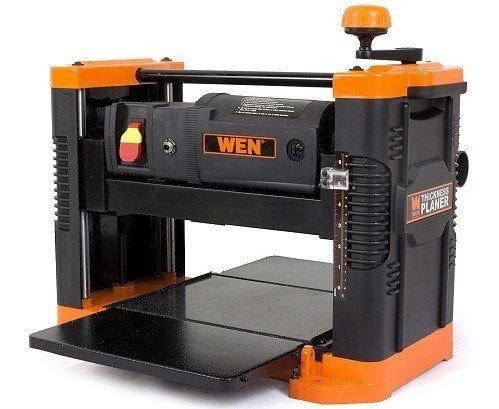 | 2. Wen 6552 Benchtop Thickness Planer | Benchtop | 15 Amps | 18,800 RPM | 4.3 | |
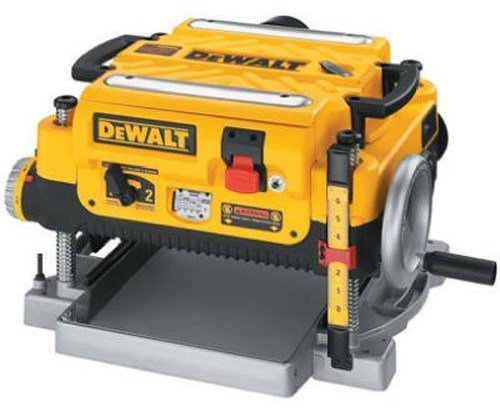 | 3. DeWalt DW735 Two Speed Thickness Planer | Thickness | 15 Amps | 10,000 RPM | 4.5 | |
 | 4. DeWalt DW680K Wood Planer | Handheld | 7 Amps | 15,000 RPM | 4.5 | |
 | 5. Makita KP0810 Wood Planer | Handheld | 7.5 Amps | 16,000 RPM | 4.5 | |
 | 6. Porter-Cable PC305TP Thickness Planer | Thickness | 15 Amps | 16,000 RPM | 4.4 | |
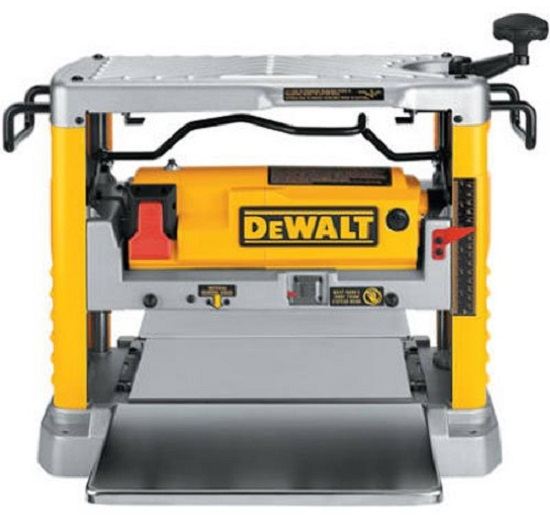 | 7. DeWalt DW734 Benchtop Wood Planer | Benchtop | 15 Amps | 20,000 RPM | 4.5 | |
 | 8. Porter-Cable PC60THP Hand Planer | Handheld | 6 Amps | 16,500 RPM | 4.5 | |
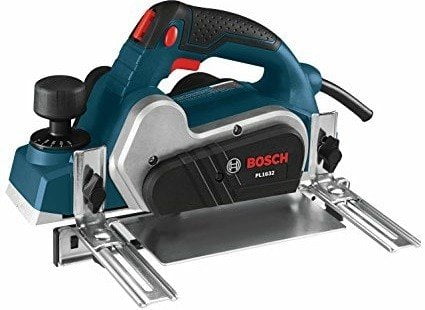 | 9. Bosch PL1632 Wood Planer | Handheld | 6.5 Amps | 16,500 RPM | 4.5 | |
 | 10. Hitachi P18DSLP4 Handheld Planer | Handheld | 18V, No Battery | 16,000 RPM | 4.6 |
10 Best Wood Planers - Reviews
#1. Wen 6530 Electric Wood Planer
Editor's Rating:  (4.4 / 5)
(4.4 / 5)

- Type: Handheld
- Power: 6-Amp
- Speed: 34,000 RPM
- Weight: 6.5 lbs
Wen 6530 is the cheapest and one of the lightest items on our wood planer reviews. These traits make it a very convenient tool to buy, and it will be useful for both beginners and experienced woodworker.
It runs on a 6-Amp motor that might not be as powerful as many others on our list but it still provides an impressive speed of 34,000 cuts per minute.
This handheld wood planer features a widely adjustable cutting depth thanks to the 16 positive stops that allow users to choose depths anywhere between 0 and 1/8-inch.
You will also get a rabetting guide with this wood planer that will adjust between 0 and 7/10 of an inch to allow you to cut rabbets up to an inch deep.
There is also a handy kickstand on the tool that helps to prevent any unwanted tool and workpiece contact. And the tool comes with a reversible dust bag that can attach to either the right or left of the planer for more efficient dust management.
Pros:
Cons:
[su_asin asin="B00OW5AJTG"]
#2. Wen 6552 Benchtop Thickness Planer
Editor's Rating:  (4.3 / 5)
(4.3 / 5)

- Type: Benchtop
- Power: 15-Amp
- Speed: 18,800 RPM
- Weight: 79 lbs
Wen 6552 is designed to offer the efficiency and power of a thickness planer but with the portability and convenience of a benchtop planer.
It runs on a powerful 15-Amp motor will deliver speeds of up to 18,800 RPM for fast and efficient planing. And it comes with a granite table that will provide a sturdy and non-marring surface for your stock to pass through.
Both the infeed and outfeed tables are foldable, and they will not only provide support for longer workpieces but also make the tool easier to store and carry. This wood plane will handle materials that are up to 6 inches thick and 12.5 inches wide.
Rubber adjustment handle makes the planer more comfortable to operate and it uses a tri-roller feed system to minimize snipe.
Dust collection is also much easier with this wood planer as the fan-assisted dust port allows you to connect a shop vac or any other dust extraction device.
Pros:
Cons:
[su_asin asin="B07KL4L9KM"]
#3. DeWalt DW735 Two Speed Thickness Planer
Editor's Rating:  (4.5 / 5)
(4.5 / 5)

- Type: Thickness
- Power: 15-Amp
- Speed: 10,000 RPM
- Weight: 92 lbs
DeWalt is one of those wood planer brands that you can always expect to have high-quality products given their reputation. If you are looking for a thickness planer, you can trust that the DeWalt DW735 will not disappoint you.
Like many other thickness planers out there it runs on a powerful 15-Amp motor to ensure that it has what it takes to handle heavy-duty planing tasks.
This wood planer uses a three-knife cutter head that operates at 10,000 RPM to speed up the job. These knives are designed to last longer than most others and they are also disposable and easy to change.
DeWalt DW735 will provide a maximum cut depth of 1/8-inch and will cut materials that are up to 6 inches thick and 13 inches wide.
With the two-speed gearbox on this wood planer, you will also get to choose between 96 and 179 CPI for optimal cuts per inch. And the fan-assisted dust port makes dust collection more efficient.
Pros:
Cons:
[su_asin asin="B0000CCXU8"]
#4. DeWalt DW680K Wood Planer
Editor's Rating:  (4.5 / 5)
(4.5 / 5)

- Type: Handheld
- Power: 7-Amp
- Speed: 15,000 RPM
- Weight: 6.2 lbs
At a total weight if just 6.2 pounds, the DeWalt DW680K is the lightest item on our list, and it is also quite compact to make it easy to carry to different job sites.
This handheld planer runs on a 7-Amp motor that will generate up to 15,000 RPM which should be enough for most planing projects in the workshop.
And with a maximum cut of 3/32-inch for every pass, you will make fewer passes to get the smoothness you need, and so it helps to speed up your projects.
Depth adjustment is easy and accurate when using this wood planer thanks to the calibrated depth adjustment knob which also eliminates the need to re-zero the depth.
DeWalt DW680K will accept various kinds of blades which include the large, resharpenable high-speed steel blade for framing and edging applications, and the reversible carbide blades for more accurate and detailed tasks.
Pros:
Cons:
[su_asin asin="B00005NMRI"]
#5. Makita KP0810 Wood Planer
Editor's Rating:  (4.5 / 5)
(4.5 / 5)

- Type: Handheld
- Power: 7.5-Amp
- Speed: 16,000 RPM
- Weight: 7.3 lbs
The relatively more powerful 7.5-Amp motor makes the Makita KP0810 one of the best handheld planers out there. This motor generates up to 16,000 RPM for fast material removal.
Makita KP0810 uses a dual-blade cutter head to ensure fast material removal, and it is made with rigid die-cast aluminum housing for increased durability.
The on/off button is conveniently located to allow the user to operate it from either side of the handle which adds to the ease of use of the tool.
With the ergonomically designed and rubberized grip and depth adjustment knob, this handheld planer is also easier and more comfortable to operate. The knob also features a scale that is easy to read and with 0.1 increment for more precise depth setting.
There is also a spring-loaded stand on the wood planer to elevate the base so that it does not damage the workpiece or blades when not in use.
Pros:
Cons:
[su_asin asin="B001ASDU7G"]
#6. Porter-Cable PC305TP Thickness Planer
Editor's Rating:  (4.4 / 5)
(4.4 / 5)

- Type: Thickness
- Power: 15-Amp
- Speed: 16,000 RPM
- Weight: 62 lbs
If you are looking for a thickness planer that will always provide a smooth finish and consistent stick thickness every time the Porter-Cable PC305TP is a great pick.
Although it is the priciest item on our list, the features and capability also make it one of the best thickness planers out there.
The wood planer runs on a powerful 15-Amp motor that is designed to generate speeds of up to 16,000 RPM. And at a total weight of 62 pounds, it is relatively lightweight for a thickness wood planer.
With the solid steel cutter head on this wood planer, you can be confident of a smoother operation and longer tool life. It also uses two quick change knives that also help to improve performance and minimize tool downtimes.
Porter-Cable PC305TP has a patented cutter elevation on the four columns to ensure superior cut stability. And it will be a great tool for dimensioning lumber to a specific thickness or even planing wood pieces that have already been glued-up.
Pros:
Cons:
[su_asin asin="B003RUHQLG"]
#7. DeWalt DW734 Benchtop Wood Planer
Editor's Rating:  (4.5 / 5)
(4.5 / 5)

- Type: Benchtop
- Power: 15-Amp
- Speed: 20,000 RPM
- Weight: 80 lbs
DeWalt DW734 is one of the best wood planers for home use out there as is not only powerful but also relatively easy to use for both professionals and DIYers.
This benchtop planer runs on a powerful 15-Amp motor with speeds of up to 20,000 RPM and with a three-knife cutter head that will deliver 96 cuts per inch for a super fine finish.
The planer uses reversible and disposable knives that will deliver a longer knife life than most others, and are also easy to change as you will only need one tool to do it.
Because snipe is one of the most common problems for wood planers, the DeWalt DW734 is designed to address it with a four-column carriage lock that reduces it drastically.
And with the extra long infeed and outfeed tables on this DeWalt wood planer, you get up to 33-1/2 inches of material support.
Pros:
Cons:
[su_asin asin="B0000CCXU6"]
#8. Porter-Cable PC60THP Hand Planer
Editor's Rating:  (4.5 / 5)
(4.5 / 5)

- Type: Handheld
- Power: 6-Amp
- Speed: 16,500 RPM
- Weight: 8.4 lbs
The relatively affordable price tag, fast planing, and efficient dust management makes the Porter-Cable PC60THP the best wood planer for the money, and to get something better you will have to spend way much more.
Although its 6-Amp motor does not seem very powerful when compared to others on our list, it should still be enough for most DIYers and hobbyists with small projects.
The planer has dual side dust extraction ports that will make it possible to extract dust from either side of the tool which can be very convenient.
Its overmold depth knob will offer 10 positive stops that will allow for better planer control and multiple depth settings for increased tool versatility.
There are also 3 chamfering grooves to give you more options for edge chamfering, and there is also an 11.5-inch cast aluminum shoe that will provide added control and better finish quality.
Pros:
Cons:
[su_asin asin="B00PSPUWV4"]
#9. Bosch PL1632 Wood Planer
Editor's Rating:  (4.5 / 5)
(4.5 / 5)

- Type: Handheld
- Power: 6.5-Amp
- Speed: 16,500 RPM
- Weight: 9.88 lbs
The best wood planer is one that not only does the job fast and efficiently but is also designed to be convenient and easy to use like the Bosch PL1632.
This handheld wood planer runs on a 6.5-Amp motor which will deliver a speed of up to 16,500 RPM to ensure fast and smooth stock removal in both softwoods and hardwoods.
And it comes with a spring-loaded stand that will be very useful in protecting both the workpiece and blade when the tool is not in use.
Planing workpieces like door edges should also be simple with this wood planer thanks to the dual-mount guide fence which also has a protective shield and plastic overshoe to prevent marring.
There are separate metric and inch depth scales on this wood planer that will make plane depth setting easy.
To ensure comfortable operation, the handle is also optimally-angled to suit the forward motion of the tool and with a soft grip.
Pros:
Cons:
[su_asin asin="B00UVXYU84"]
#10. Hitachi P18DSLP4 Handheld Planer
Editor's Rating:  (4.6 / 5)
(4.6 / 5)

- Type: Handheld
- Power: 18 Volts
- Speed: 16,000 RPM
- Weight: 7.3 lbs
For the woodworkers that are always moving from one job site to the other and want a wood planer that they can carry along, the Hitachi P18DSLPA is a perfect choice.
This cordless handheld planer runs on 18V lithium-ion batteries, and it is capable of generating no-load speeds of 16,000 RPM for fast material removal.
And for a battery-powered planer, the 7.3 pounds total weight is relatively lightweight which makes it highly portable and this is more so given its compact size.
It also has a decent cutting capability as it can cut materials that are up to 3-1/4 inches wide and with a cutting depth of 5/64-inch.
The soft grip handle helps to improve user comfort and minimizes fatigue when using the planer for extended periods.
There is also a battery level indicator to notify you when the battery is running out, and a stand on the rear side to help prevent accidental blade contact with the workpiece.
Pros:
Cons:
[su_asin asin="B00O0ROILQ"]
Types of Wood Planer
As a woodworker or DIYer that uses various kinds of tools, it is always important to know your tools well as this helps you determine what works best for your projects.
For wood planers, this means you should start by understanding the different types available in the market and their pros and cons. And here are the five most common types of wood planers.
#1. Handheld Planers

Handheld planer refers to the types operated by hand which are among the oldest and most common of all types.
The simplest way to define these planers is that they are a motorized version of the traditional hand planers. They can either be cordless or corded- electric and will feature a serrated edge parallel to the surface you are planing.
With the handheld wood planers, planing is done by moving it over the stock from the lesser thick end toward the thicker end of the workpiece. Moving it across the stock results in shaving off of material as the serrated edge comes into contact with the wood.
Despite the invention of more efficient and faster electric wood planers, you will still find handheld planers in many workshops.
Best for: Many woodworkers still prefer using it as a side tool for small finishing purpose as it gives them more control when planing. These wood planes are a great backup tool even for woodworkers and DIYers that own the large stationary planers.
Pros:
Cons:
#2. Thickness Planers

Sometimes you want your stock to be of a very particular thickness and uniform throughout. While a handheld wood planer can still help you achieve this if you are an experienced woodworker, a thickness planer is often the best tool for the job.
Thickness wood planers are designed to shave off a few inches of the stock at once to level the stock to a particular thickness.
Although thickness planers are in most cases small and quite portable, they often need a lot of space to operate.
Pros:
Cons:
Best for: They are a good buy for DIYers and hobbyists that would like to save some cash by going for unfinished wood and using a thickness planer to work on it.
#3. Benchtop Planers

Benchtop wood planers are similar to the portable planers but they are slightly larger in size and need to be placed on a flat and sturdy surface for efficient use.
These wood planers are more powerful and so they will produce deeper cuts meaning they have what it takes to handle thicker material. Most use an induction motor which explains their high power output.
With a benchtop wood planer, you can plane almost any kind of wood and their size and weight also make them moderately portable.
Pros:
Cons:
Best for: For those that have heavy planing projects, work with hardwoods a lot or own a professional workshop, there is almost no other better alternative to getting the best benchtop planer.
#4. Portable Planers
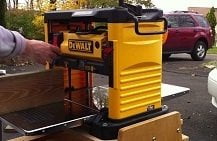
All handheld wood planers are portable but the reverse is not true. Portable wood planers are basically a miniature version of the powerful stationary planers that is designed to be more compact and lightweight to make them easy to carry around.
Like the benchtop wood planers, they need to be placed on a flat and sturdy surface from where you can operate them. But, because the aim is to keep their weight down they often have a smaller and hence less powerful motor.
Pros:
Cons:
Best for: These wood planers are great for tiny workshops, woodworkers looking for something to carry from one work site to the other, and hobbyists or DIYers that love doing home repairs and improvements.
#5. Jointer-Planer Combo

Jointers and planers are both very useful tools to have in the workshop but buying both can be quite an expensive venture for most woodworkers.
The jointer planer combo solves this problem by serving the purpose of both tools. This tool allows you to multitask or do two things at a time.
They are relatively more affordable than buying the two tools separately and are also more powerful and highly reliable.
Pros:
Cons:
Best for: Those looking for a good wood planer for their medium size workshop and will also love to have a jointer for their large projects. However, these types of planer might not be very useful for the average DIYer.
How to Buy the Best Wood Planers

If you are a professional woodworker or one of those DIYers that tend to do a lot of woodworking projects, the chances are that you will end up with more than one wood planer type at some point.
But, when it comes to buying one of these handy tools, there are some vital things that you need to consider to ensure you make the right pick. And they include the 7 below.
#1. Motor
The motor is one of the key elements that will set different wood planer apart. And it is what will determine the amount of power the planer can generate.
Wood planers will often use either an induction or universal motor. Induction motors are the more durable and robust of the two. They are also relatively more lightweight and they are the best choice for wood planers meant for industrial use or permanent installation in a workshop.
Universal motors, on the other hand, are lighter and more compact than the induction types. Hence, they are more suitable for the portable wood planers.
Besides considering the type of motor and whether it is powerful enough for your projects or not, you also need to consider the voltage requirements and buy one that suits your workshop.
#2. Available Space
When buying large equipment like wood planers, you need to make sure that your workshop, garage or anywhere else you intend to have it has enough space to accommodate it.
Also, space not only needs to be enough to hold the planer but also to make it easy to use and maneuver. And so you also need to take into account the size of the material you will be working on when deciding whether the workshop space will be large enough or not.
It is clear that all this will not be applicable for you if you are looking to buy a handheld or the small portable planer.
#3. Thickness and Width
The capacity of the wood planer is another important factor to consider as it determines how useful it will be for your kind of projects. And here you need to consider both thickness and width capacity.
Thickness capacity is the maximum stock thickness that the planer can comfortably take while the width capacity is how wide the stock can be.
Wood planers meant for industrial setting offer the best capacity for those that work with large volumes of rough stock. Portable planers, on the other hand, can offer adequate thickness capacity for the small and medium projects.
#4. Stroke Count
The blades that wood planers use to plane materials have knives which rotate at high speed to shave off wood from the surface of the stock.
The more the knives on the blade the higher the stroke count. Also, the higher the speed of the wood planer’s blade the more the stroke count.
However, when it comes to wood planers, stroke count or speed is not an indication of quality. For some stock types, slower blades produce much better results while for others fast ones are the best. Hence, the best wood planers are ones that have variable speed.
#5. Dust Collection
Just like sanding, planing produces a lot of wood dust, and so before you settle on any wood planer you should make sure it has an efficient system for managing or collecting this dust.
Luckily, many top-rated wood planer brands have this covered as most of their wood planer models will have integrated fans to suck all the chips and dust away from the cutting head. The dust is then blown away through the dust port.
Some models will allow you to connect a shop vac on the dust port while others come with a bag for catching the wood dust. Here you should go for what you find most convenient.
#6. Warranty
You do not need to be told just how important a warranty is when buying any tool and this is especially so with a tool like a wood planer with various moveable parts and electrical components.
And besides choosing a brand that offers a long warranty, you should also check carefully what is covered and what is not to avoid disappointments when you need to claim the warranty.
#7. Price
When it comes to wood planer price, it will vary from one type to the other and also between different brands. The quality and features are also major determinants of the price but the most important thing is always to go for something that suits your budget.
Also, take into account other things like the cost of installation if any and subsequent maintenance as they can make what seems like an affordable wood planer more costly.
But, do not always go for the cheapest wood planer because like with most other tools, you always get what you pay for.
Read More: Planer vs. Jointer: Which Is Better For You?
Conclusion
If you are going to be doing woodworking projects regularly you need to invest in a good wood planer.
Choosing from the many options out there can be confusing but you only need to understand what the different types have to offer, the motor, stroke count, and a few other things.
Ultimately the right wood planer for you will depend on your workload and skills. But, with our top 10 best wood planer reviews above you should now have a good idea on what you should be looking for.
Last Updated on March 4, 2020 by Tom Bradly
